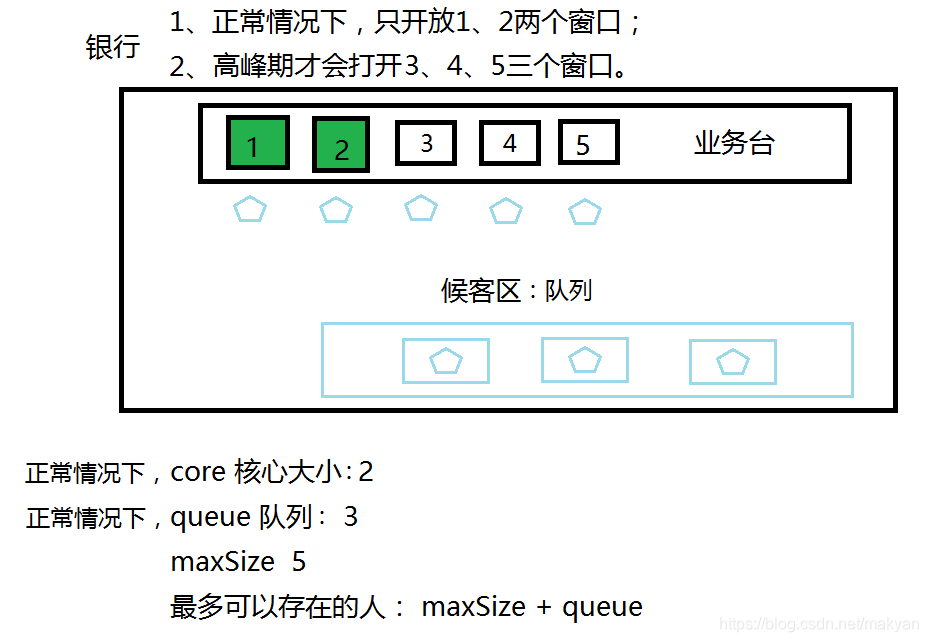11、线程池
线程池重点内容:三大方法、7大参数、拒绝策略、优化配置。
11.1. 线程池原理
池化技术
程序运行的本质:占用系统资源,CPU/磁盘网络进行使用!我们希望可以高效的使用!池化技术就是演进出来的。
简单的说,池化技术就是:提前准备一些资源、以供使用!
线程池、连接池、内存池、对象池…这些东西都是池化技术。
线程的创建和销毁,数据库的连接和断开都十分浪费资源。
只要是“池”,就会设计到两个常量:minSize、maxSize,这些就是为了弹性访问,保证系统运行的效率。
如下,去银行取钱示例:

11.2. 为什么使用线程池
为什么使用线程池
如果你使用的是单核电脑,那你电脑上运行的多线程,都是假的,它运行原理是一个CPU对各个线程的交替执行,速度块。
但随着业务的发展,还是不能满足业务的要求,降低工作效率。现在我们使用的电脑是多核多CPU,各自的线程跑在独立的CPU上,不用切换,效率高很多。
线程池的优势:
1、控制运行的线程数量,处理的时候可以把一些任务放入队列 ;
2、实现线程的复用!控制最大并发数!
11.3. 创建线程池的三大方法
创建线程池的三大方法


数组有工具类Arrays,集合有工具类Collections,线程池同样有工具类Executors。利用线程池工具类Executors来创建线程池。线程池 Executors原生三大方法:
1、ExecutorService threadpool1 = Executors.newFixedThreadPool(5); // 固定线程池大小
2、ExecutorService threadpool2 = Executors.newCachedThreadPool(); //可以弹性伸缩的线程池,遇强则强
3、ExecutorService threadpool3 = Executors.newSingleThreadExecutor(); // 只有一个
线程池编写模型:
1、创建线程池 : ExecutorService threadpool = …
2、线程池执行线程: threadpool.execute();
3、关闭线程池 : threadpool.shutdown()。
Executors.newFixedThreadPool()示例:
/**
* @description: 超过线程池大小部分,将拒绝
* @author yangxj
* @date 2020/2/24 10:45
*/
public static void fixedThreadPool() {
/**
* @description: 线程池使用三部曲:1、创建线程池
*/
ExecutorService executorService = Executors.newFixedThreadPool(5);// 固定大小
//线程池要关闭,一般关闭我们放在finally中执行
try {
for (int i = 0; i < 10; i++) {
/**
* @description:线程池使用三部曲:2、线程池执行线程
*/
executorService.execute(() -> System.out.println(Thread.currentThread().getName() + ":running"));
}
} catch (Exception e) {
e.printStackTrace();
} finally {
/**
* @description:线程池使用三部曲:3、关闭线程池
*/
executorService.shutdown();
}
}
超过线程池大小的线程将拒绝,只有5个线程在执行任务,运行效果如下:

Executors.newCachedThreadPool()示例:
/**
* @description: 线程池大小根据请求量自动扩张
* @author yangxj
* @date 2020/2/24 10:45
*/
public static void cachedThreadPool() {
/**
* @description: 线程池使用三部曲:1、创建线程池
*/
ExecutorService executorService = Executors.newCachedThreadPool();//可以弹性伸缩的线程池
//线程池要关闭,一般关闭我们放在finally中执行
try {
for (int i = 0; i < 10; i++) {
/**
* @description:线程池使用三部曲:2、线程池执行线程
*/
executorService.execute(() -> System.out.println(Thread.currentThread().getName() + ":running"));
}
} catch (Exception e) {
e.printStackTrace();
} finally {
/**
* @description:线程池使用三部曲:3、关闭线程池
*/
executorService.shutdown();
}
}
线程池大小根据请求量自动扩张,有10个线程在执行任务,运行效果如下:

Executors.newSingleThreadExecutor()示例:
/**
* @description: 线程池大小只有一个
* @author yangxj
* @date 2020/2/24 10:45
*/
public static void singleThreadExecutor() {
/**
* @description: 线程池使用三部曲:1、创建线程池
*/
ExecutorService executorService = Executors.newSingleThreadExecutor(); // 只有一个
//线程池要关闭,一般关闭我们放在finally中执行
try {
for (int i = 0; i < 10; i++) {
/**
* @description:线程池使用三部曲:2、线程池执行线程
*/
executorService.execute(() -> System.out.println(Thread.currentThread().getName() + ":running"));
}
} catch (Exception e) {
e.printStackTrace();
} finally {
/**
* @description:线程池使用三部曲:3、关闭线程池
*/
executorService.shutdown();
}
}
线程池大小只有1个,只有1个线程在执行任务,运行效果如下:

11.4. ThreadPoolExecutor 七大参数
ThreadPoolExecutor 七大参数
分析三个方法的源码
public static ExecutorService newFixedThreadPool(int nThreads) {
return new ThreadPoolExecutor(int corePoolSize, int maximumPoolSize,
0L, TimeUnit.MILLISECONDS,
new LinkedBlockingQueue<Runnable>());
}
public static ExecutorService newCachedThreadPool() {
return new ThreadPoolExecutor(0, Integer.MAX_VALUE,
60L, TimeUnit.SECONDS,
new SynchronousQueue<Runnable>());
}
public static ExecutorService newSingleThreadExecutor() {
return new FinalizableDelegatedExecutorService
(new ThreadPoolExecutor(1, 1,
0L, TimeUnit.MILLISECONDS,
new LinkedBlockingQueue<Runnable>()));
}
线程池的三大方法最终调用的都是ThreadPoolExecutor,一共有7个参数
ThreadPoolExecutor核心方法:
public ThreadPoolExecutor(int corePoolSize, // 核心池子的大小
int maximumPoolSize, // 池子的最大大小
long keepAliveTime, // 空闲线程的保留时间
TimeUnit unit, // 时间单位
BlockingQueue<Runnable> workQueue, // 队列
ThreadFactory threadFactory, // 线程工厂,不修改!用来创建线程
RejectedExecutionHandler handler // 拒绝策略) {
if (corePoolSize < 0 ||
maximumPoolSize <= 0 ||
maximumPoolSize < corePoolSize ||
keepAliveTime < 0)
throw new IllegalArgumentException();
if (workQueue == null || threadFactory == null || handler == null)
throw new NullPointerException();
this.acc = System.getSecurityManager() == null ?
null :
AccessController.getContext();
this.corePoolSize = corePoolSize;
this.maximumPoolSize = maximumPoolSize;
this.workQueue = workQueue;
this.keepAliveTime = unit.toNanos(keepAliveTime);
this.threadFactory = threadFactory;
this.handler = handler;
}
思考:工作中怎么使用线程池?只能够自己根据业务情况去自定义线程池的大小策略,禁止使用Executors。
阿里巴巴孤尽强调,禁止使用Executors去创建线程池。

使用Executors创建的线程池容易发生OOM. 因为它允许的其你去队列大小是integer最大值。
ThreadPoolExecutor 底层工作原理

package com.interview.concurrent.threadpool;
import java.util.concurrent.*;
/**
* @author yangxj
* @description 描述:线程池7大参数的使用
* 1、队列满了,就会触发最大线程池,否则永远都只是corePoolSize个线程在运行,所以,队列大小一定要根据业务情况进行设置;
* 2、当请求线程超过线程池(maximumPoolSize + workQueue),就会触发拒绝策略,至于怎么拒绝,与拒绝策略RejectedExecutionHandler有关。
* @date 2020/2/24 11:03
*/
public class ThreadPoolExecutorDemo {
public static void main(String[] args) {
threadPoolExecutor();
}
public static void threadPoolExecutor(){
ExecutorService threadPool = new ThreadPoolExecutor(
2, // 核心池子的大小
5, // 线程池最大大小5
2L, // 空闲线程的保留时间
TimeUnit.SECONDS, // 超时回收空闲的线程
new LinkedBlockingDeque<>(3), // 根据业务设置队列大小,队列大小一定要设置
Executors.defaultThreadFactory(), // 不用变
new ThreadPoolExecutor.CallerRunsPolicy() //拒绝策略
);
// 拒绝策略说明:
// 1. AbortPolicy (默认的:队列满了,就丢弃任务抛出异常!)
// 2. CallerRunsPolicy(哪来的回哪去? 谁叫你来的,你就去哪里处理)
// 3. DiscardOldestPolicy (尝试将最早进入对立与的人任务删除,尝试加入队列)
// 4. DiscardPolicy (队列满了任务也会丢弃,不抛出异常)
try {
// 队列 RejectedExecutionException 拒绝策略
for (int i = 1; i <= 10; i++) {
// 默认在处理
threadPool.execute(()->{
System.out.println(Thread.currentThread().getName()+" running....");
});
}
} catch (Exception e) {
e.printStackTrace();
} finally {
threadPool.shutdown();
}
}
}
注:
1、队列满了,就会触发最大线程池,否则永远都只是corePoolSize个线程在运行,所以,队列大小一定要根据业务情况进行设置;
2、当请求线程超过线程池(maximumPoolSize + workQueue),就会触发拒绝策略,至于怎么拒绝,与拒绝策略RejectedExecutionHandler有关。
11.5. 四种拒绝策略
四种拒绝策略:

拒绝策略说明:
- AbortPolicy (默认的:队列满了,就丢弃任务抛出异常!);
- CallerRunsPolicy(哪来的回哪去? 谁叫你来的,你就去哪里处理);
- DiscardOldestPolicy (尝试将最早进入队列的任务删除,尝试加入新任务);
- DiscardPolicy (队列满了任务也会丢弃,不抛出异常)。
流程图:

线程池用哪个?生产中如何设置合理参数
在工作中,我们不会使用Executors,自定根据业务来定义线程池!
11.6. 优化配置
注意点:最大参数该如何设置?可通过以下两种方式去设置
1、CPU 密集型:最大支持多少个线程同时跑,根据CPU去设置,一般设置成与CPU处理器一样大,每一次都要去写吗? 通过Runtime来获取。
Runtime.getRuntime.availableProcessors();2、IO 密集型:磁盘读写、 一个线程在IO操作的时候、另外一个线程在CPU中跑,造成CPU空闲。最大线程数应该设置为 IO任务数! 对于大文件的读写非常耗时,我们应该用单独的线程让他慢慢跑。
可以将以上代码的最大线程池使用Runtime.getRuntime.availableProcessors();来代替,如下代码:
package com.interview.concurrent.threadpool;
import java.util.concurrent.*;
/**
* @author yangxj
* @description 描述:线程池7大参数的使用
* 1、队列满了,就会触发最大线程池,否则永远都只是corePoolSize个线程在运行,所以,队列大小一定要根据业务情况进行设置;
* 2、当请求线程超过线程池(maximumPoolSize + workQueue),就会触发拒绝策略,至于怎么拒绝,与拒绝策略RejectedExecutionHandler有关。
* @date 2020/2/24 11:03
*/
public class ThreadPoolExecutorDemo {
public static void main(String[] args) {
threadPoolExecutorRuntimeProcessors();
}
public static void threadPoolExecutorRuntimeProcessors(){
ExecutorService threadPool = new ThreadPoolExecutor(
2, // 核心池子的大小
Runtime.getRuntime().availableProcessors(), // 获取当前运行环境的可用线程数
2L, // 空闲线程的保留时间
TimeUnit.SECONDS, // 超时回收空闲的线程
new LinkedBlockingDeque<>(3), // 根据业务设置队列大小,队列大小一定要设置
Executors.defaultThreadFactory(), // 不用变
new ThreadPoolExecutor.CallerRunsPolicy() //拒绝策略
);
// 拒绝策略说明:
// 1. AbortPolicy (默认的:队列满了,就丢弃任务抛出异常!)
// 2. CallerRunsPolicy(哪来的回哪去? 谁叫你来的,你就去哪里处理)
// 3. DiscardOldestPolicy (尝试将最早进入对立与的人任务删除,尝试加入队列)
// 4. DiscardPolicy (队列满了任务也会丢弃,不抛出异常)
try {
// 队列 RejectedExecutionException 拒绝策略
for (int i = 1; i <= 10; i++) {
// 默认在处理
threadPool.execute(()->{
System.out.println(Thread.currentThread().getName()+" running....");
});
}
} catch (Exception e) {
e.printStackTrace();
} finally {
threadPool.shutdown();
}
}
}
